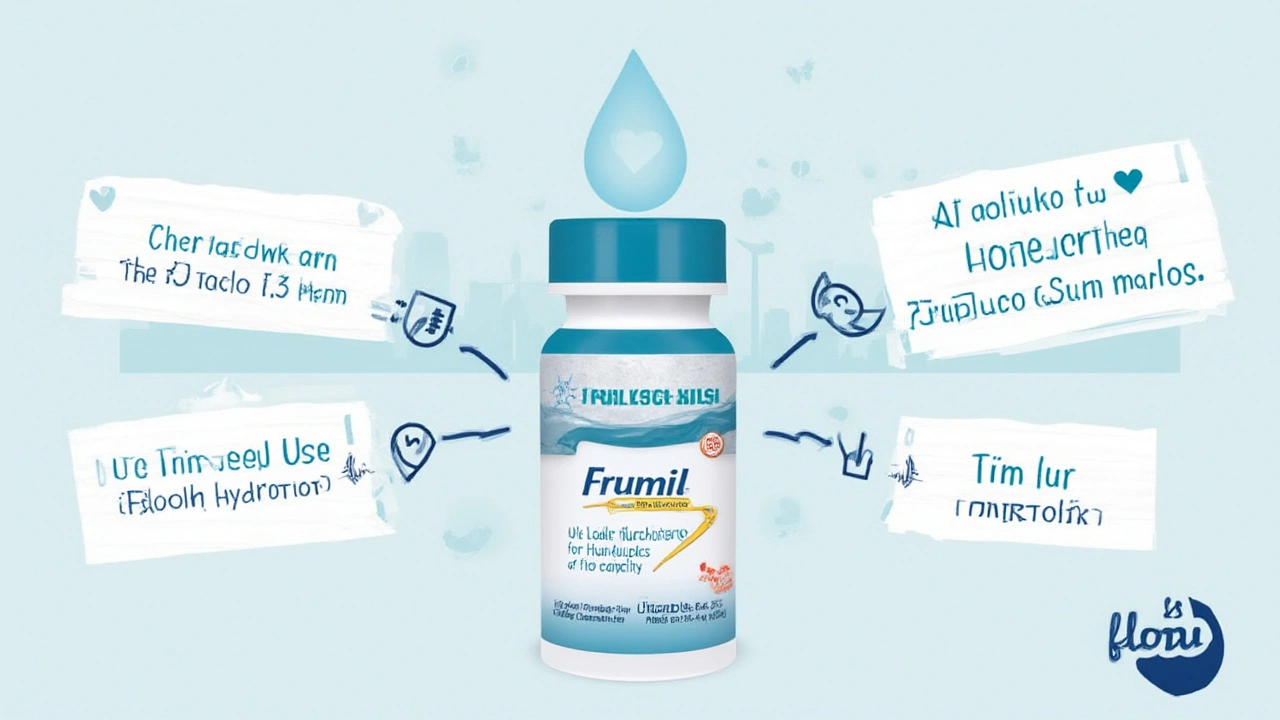Seen those tiny yellow pills in your parent’s medicine cabinet? Or maybe your doctor just handed you a prescription and you’re wondering, what’s the real story behind Frumil? Here’s something wild: back in the early 1970s, people who had swelling in their legs or struggled with stubborn high blood pressure thought they were just doomed to live with it. Frumil changed that game, showing up as a two-in-one solution and sticking around as a trusty go-to for folks everywhere. Forget cold scientific explanations—let’s break down what this med really means for you if you or someone you love has ever been told, "You need to lower your blood pressure or reduce extra fluid."
What Exactly Is Frumil?
Frumil isn’t some fancy new pill. It’s been a staple in hypertension and water retention treatment for decades. Here’s the scoop: it combines two medicines—amiloride and furosemide. Think of it like a tag team. Furosemide is a loop diuretic, basically a water pill that wakes up your kidneys and tells them to send extra salt and water packing. Amiloride, on the other hand, hangs around to keep your body from losing too much potassium, which is a sneaky risk with most water pills.
Doctors love using Frumil because it’s simple: one tablet, two jobs. Patients don’t have to juggle bottles. It treats edema—that’s just a fancy word for swelling due to fluid building up in places like your feet, ankles, or lungs. It also reins in high blood pressure. That’s a big deal since high BP is often called the “silent killer”—you might not feel it ticking away, but it’s doing a number on your heart, blood vessels, and kidneys over the long haul.
The combo in Frumil means doctors often prescribe it for people who respond poorly to plain furosemide or who can’t risk dropping their potassium levels. The popularity is not just due to convenience—it’s efficiency and safety wrapped in one. If you keep forgetting to take separate pills or your potassium keeps dipping low, this mix really helps.
So, if you see ‘amiloride 5mg and furosemide 40mg’ on your box, that’s the typical strength. And if you’re curious, Frumil isn’t used for quick fixes—it’s a daily routine kinda thing. Miss a dose? Don’t double up, just get back on track the next day. Little details like these matter more than most realize.
How Frumil Works Inside Your Body
Alright, real talk—how does this pill actually help? Picture your kidneys like a pair of sophisticated filters. Frumil steps in and nudges them to kick out extra salts and water, which leaves your bloodstream with less volume to push around. That fairly simple action helps bring down your blood pressure and reduces all that uncomfortable swelling.
The two components have distinct missions. Furosemide acts fast, prompting the kidneys to let go of sodium, chloride, and water, usually leading to more frequent bathroom trips within a couple hours. While that solves the swelling issue, it has a sneaky habit of sweeping away potassium too. Enter amiloride, which acts like a guard, holding on to valuable potassium in your body and minimizing muscle cramps, weakness, or even irregular heartbeats that sometimes happen with classic diuretics.
One thing most people don’t know: diuretics like Frumil actually help your heart. If your heart can’t pump blood well enough (a problem called heart failure), your body thinks you need to hang onto every drop of water, which backfires. Frumil tells your kidneys, "No, let’s clear out the extra water." That means less fluid for your heart to push against, making its job easier. This is why you’ll see Frumil prescribed for folks with heart failure or liver disease, not just those trying to tame their blood pressure.
While results are impressive, it’s not instant magic. You might notice less swelling in a few days, but blood pressure control is a long game. Your doctor checks your blood and pressure every so often to fine-tune the dose and keep things running smoothly.

Common Side Effects and How to Handle Them
No pill is perfect and Frumil is no exception. So, what can you expect? Most people notice more frequent urination—that’s the point, after all. You might have to plan bathroom breaks if you’re out, especially during the first week of taking it. Dehydration can sneak up if you’re not careful, especially on hot summer days in Boston or if you’re really active.
Here’s what else to look out for:
- Dizziness or lightheadedness, especially when you stand up quickly. Since your blood pressure is dropping, your body needs time to adjust.
- Dry mouth or excessive thirst. That’s your cue to drink water, but not to chug gallons—just enough to feel comfortable.
- Muscle cramps or weakness. This can sometimes mean your potassium is off, so amiloride is there to help, but it’s still a possible side effect.
- Rarely, tummy upset or rash. If this happens, let your doctor know.
Potassium is a big deal here. Frumil usually keeps those levels steady, yet some people (especially those with kidney problems or on certain supplements) might overshoot. Ever get a weird tingling or heavy feeling in your legs, or you’re suddenly more tired than usual? Mention it at your next check-up.
One handy tip: try to take Frumil in the morning. Dosing at night can mess with your sleep—nobody wants to deal with bathroom trips at 2 a.m. Also, keep tabs on your blood pressure at home. Blood pressure cuffs aren’t just for the doctor’s office anymore. They’re on shelves everywhere, and they’re cheaper than you might think. This helps your doc adjust things without endless office visits.
If you’re worried about interactions, Frumil plays well with most meds, but it can clash with NSAIDs (like ibuprofen) or other blood pressure pills. Always run new meds by your doctor or pharmacist. And tell them if you’re on lithium or have any kidney trouble. Sometimes a small tweak makes a big difference.
Who Should (and Shouldn't) Use Frumil
So who actually needs this combo? Doctors often reach for Frumil when someone’s swollen ankles or sky-high blood pressure aren’t budging with plain water pills, or when that potassium drop becomes an issue. It’s a staple for older adults, especially those juggling multiple medications or managing chronic conditions like heart failure.
But here’s the deal—Frumil isn’t for everyone. People with serious kidney problems, Addison’s disease, or high blood potassium levels shouldn’t use it. Pregnant or breastfeeding women should only take it if a doctor says it’s essential. If your kidneys aren’t working right, or your potassium tends to be high already, this drug can tip things out of balance fast.
Kids don’t usually get Frumil except in rare hospital cases, and if you’re an athlete or crazy about your protein shakes and bananas, mention that during appointments. It’s easy to overdo potassium, and your doctor might want to track your levels more closely.
If you forget to take a dose, don’t sweat it—just take it the next day at your usual time. Don’t double up. And since Frumil makes you urinate more, certain vitamins and minerals (magnesium, calcium) might drop, so ask if you need blood tests every now and then. This is extra important for folks taking digitalis (a heart med), as getting these levels wrong can cause dangerous rhythms.
A little bonus insight: Frumil isn’t addictive, and it doesn’t cause withdrawal. If your doctor says it’s time to stop, there’s no downside in gradually tapering off unless you’ve got specific health issues that need monitoring.

Making the Most of Your Frumil Prescription
When you’re on this med, a few small tweaks make a world of difference. First, find a time that works for you—most pick a morning routine, but if you’re stuck in rush hour traffic every day, adjust for your schedule. Setting a phone alarm or using a pill organizer helps you stay on track.
Look at your salt intake—Frumil helps get rid of extra salt, but if you pile on processed foods or grip the saltshaker like a lifeline, you’re fighting an uphill battle. Try simple swaps: lemon juice, herbs, and other spices make food tasty without the sodium hit. Your heart will thank you.
Move around. Fluid has this annoying habit of pooling when you sit all day. Even short walks or flexing your ankles can cut down on swelling and improve how well your meds work. If you notice sudden weight gain—like more than 2-3 pounds in a day—let your doctor know. That can mean your body’s holding on to fluid again and your meds need tweaking.
If you get a new cold or flu, or you’re suddenly feeling weaker, don’t just reach for over-the-counter cold pills or NSAIDs without checking. Even meds that seem innocent can trip you up when combined with Frumil. Always keep your healthcare team in the loop about any herbal remedies or vitamins. There are surprising interactions out there—liquorice, for instance, isn’t just for candy; it can raise your blood pressure and block Frumil’s effect.
Sticking with follow-up appointments is big. That bloodwork isn’t just paperwork—it makes sure Frumil’s doing its thing without causing collateral damage. Doctors can spot warning signs—like low sodium, high potassium, or kidney issues—before you even feel anything.
And about alcohol: Frumil doesn’t react dangerously with a glass of wine, but both can drop your blood pressure. Go easy until you know how your body handles the combination.
Stay hydrated but don’t overdo it. If you sweat a lot after workouts or during a heatwave in Boston’s sticky summers, talk to your doctor. Sometimes they’ll adjust your dose so you don’t tip into dehydration zone.
Finally, don’t be afraid to ask questions. Too many folks nod along at the pharmacy but wonder at home what they just signed up for. If something seems off—even if it’s just a weird feeling—call your provider. It’s your life, your health, and Frumil is here to improve it. Use it smartly, and you’ll stay ahead of the curve.


Keeping an eye on your serum potassium is crucial when you’re on Frumil; a quick finger‑stick test at the pharmacy can flag any drift before you feel the symptoms. Pair that with a low‑potassium diet if your doctor says you’re trending low, and you’ll sidestep most cramps. Hydration matters too – sip water throughout the day, but avoid chugging after you’ve taken the dose. If anything feels off, jot it down and bring it up at your next check‑up.
Think of Frumil as the Swiss Army knife of cardiovascular meds; it tackles fluid overload while safeguarding your potassium reserves, which is a game‑changer for many seniors juggling multiple prescriptions. Start each morning with your dose, then schedule bathroom breaks about an hour later – it helps you plan around work or errands without scrambling. Pair the pill with a low‑sodium diet: swap out processed snacks for fresh veggies, herbs, and citrus zest to keep your palate satisfied. Gentle foot‑elevating exercises, like ankle pumps or short walks, encourage lymphatic drainage and reduce ankle swelling. When you notice a sudden weight jump of two to three pounds in a day, that’s a red flag that fluid is re‑accumulating and you may need a dose tweak. Stay consistent with home blood pressure monitoring; many devices now sync with smartphones, giving you and your clinician real‑time trends. If you’re active, replace lost electrolytes with a potassium‑rich snack rather than a sugary sports drink – think a banana or a handful of nuts. Avoid NSAIDs unless absolutely necessary, as they can blunt the diuretic effect and stress the kidneys. And remember, alcohol can potentiate the blood‑pressure‑lowering effect, so sip responsibly. Finally, keep a medication list handy, especially if you see multiple specialists, to prevent overlapping diuretics or potassium supplements. In short, treat Frumil as a partner, not a magic bullet, and you’ll see steady improvement in both edema and blood pressure without the dreaded side‑effects.
The previous comment drifts into vague lifestyle fluff while glossing over the pharmacodynamics that truly matter. Frumil’s efficacy hinges on the synergistic blockade of the ENaC channel by amiloride, which mitigates the hypokalemia induced by furosemide’s NKCC2 inhibition. Ignoring the renal tubular intricacies reduces the discussion to a superficial health blog. Moreover, recommending “potassium‑rich snacks” without quantifying intake can precipitate hyperkalemia in patients with compromised renal clearance.
For anyone unsure about the timing, taking Frumil early in the day avoids nocturnal diuresis that can disrupt sleep. If you’re on other antihypertensives, coordinate dosing to reduce the risk of additive hypotension. A quick check of your latest lab results will confirm that sodium and potassium remain within target ranges. Should you experience dizziness, rise slowly from sitting to standing to give your body time to adjust.
Yo thats just basic med info lol.
What if we see this pill not just as a chemical but as a bridge between the body’s own equilibrium and the modern need for control? The synergy of amiloride and furosemide mirrors a dialogue between restraint and release; restraint being potassium conservation, release being fluid excretion. It is a reminder that medicine can be both art and science. In a world where shortcuts abound, Frumil forces us to respect the balance we often ignore.
Indeed, the combination leverages distinct mechanisms, allowing clinicians to fine‑tune natriuresis while preserving electrolyte homeostasis; this duality, however, demands vigilant monitoring, especially in the elderly, who may experience orthostatic hypotension,
Keeping salt low and moving a bit each day makes the diuretic work faster. Even a short walk after meals can help fluid shift out of the legs. If you track your weight weekly, you’ll spot trends early.
👍💧
The emoji‑laden affirmation, while positive, glosses over the nuanced risk–benefit analysis that underpins Frumil’s prescription. A deeper dive into the electrolyte‐balance equation is warranted; otherwise, we risk perpetuating a simplistic narrative.
Stay motivated, stay hydrated, stay on schedule. Your health journey is a marathon, not a sprint.
Grammar check: "Frumil helps you get rid of excess fluid, not just the water." 🚰💊 Remember to proofread your med notes; a typo can lead to a dosing error.
From a practical standpoint, the diuretic effect can be modeled as an increased glomerular filtration rate coupled with reduced tubular reabsorption. In lay terms, you’re flushing out more sodium and water, which directly impacts preload and afterload in cardiac physiology.
Cool explanation, thanks.
While many hail Frumil as the perfect two‑in‑one, the reality is peppered with caveats that deserve a thorough unpacking. First, the pharmacokinetic profile of furosemide is highly variable; oral bioavailability can swing between 10 % and 90 %, depending on gastric pH and concurrent food intake, meaning that two patients on the same dose may experience vastly different diuretic responses. Second, amiloride’s protective effect on potassium is not absolute – patients with compromised renal function may still drift into hypo‑ or hyper‑kalemia, especially if they self‑administer potassium‑rich supplements without medical guidance. Third, the combination can mask early signs of worsening heart failure; abrupt weight loss may be misinterpreted as improvement, while underlying congestion persists, leading clinicians to mistakenly de‑escalate therapy. Fourth, drug‑drug interactions are a silent menace: non‑steroidal anti‑inflammatory drugs (NSAIDs) blunt the prostaglandin‑mediated renal vasodilation that furosemide relies on, attenuating its natriuretic effect and potentially precipitating acute kidney injury. Fifth, the timing of administration is crucial – taking Frumil too late in the evening can fragment sleep architecture due to nocturnal polyuria, which in turn raises sympathetic tone and paradoxically spikes blood pressure the next morning. Sixth, patient adherence can be eroded by the very side effect it induces: frequent urination. If the regimen interferes with work or social activities, patients may skip doses, nullifying therapeutic gains. Seventh, the elderly population, who are the primary beneficiaries, often have diminished thirst perception, putting them at higher risk for dehydration and orthostatic hypotension, especially when combined with other antihypertensives. Eighth, dietary sodium intake remains a dominant driver of fluid retention; even the most potent diuretic cannot fully counteract a diet laden with processed foods, underscoring the importance of lifestyle counseling alongside pharmacotherapy. Ninth, laboratory monitoring should not be a one‑off event; serial checks of electrolytes, renal function, and plasma renin activity guide dose titration and prevent iatrogenic complications. Tenth, the psychological impact of visible edema reduction can create a false sense of security, leading patients to neglect other aspects of heart‑failure management such as exercise, weight monitoring, and fluid restriction. In sum, while Frumil offers a convenient pharmacologic package, its optimal use hinges on individualized dosing, vigilant monitoring, and comprehensive patient education to navigate the myriad pitfalls that accompany its dual mechanisms.
Thanks for the deep dive, everyone. Remember, you’re not alone in figuring this out – lean on your healthcare team and your community. Stay positive and keep tracking those numbers.